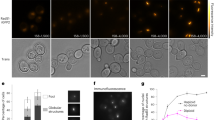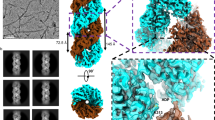Abstract
The central catalyst in eukaryotic ATP-dependent homologous recombination consists of RAD51 proteins, polymerized around single-stranded DNA. This nucleoprotein filament recognizes and invades a homologous duplex DNA segment1,2. After strand exchange, the nucleoprotein filament should disassemble so that the recombination process can be completed3. The molecular mechanism of RAD51 filament disassembly is poorly understood. Here we show, by combining optical tweezers with single-molecule fluorescence microscopy and microfluidics4,5, that disassembly of human RAD51 nucleoprotein filaments results from the interplay between ATP hydrolysis and the release of the tension stored in the filament. By applying external tension to the DNA, we found that disassembly slows down and can even be stalled. We quantified the fluorescence of RAD51 patches and found that disassembly occurs in bursts interspersed by long pauses. After relaxation of a stalled complex, pauses were suppressed resulting in a large burst. These results indicate that tension-dependent disassembly takes place only from filament ends, after tension-independent ATP hydrolysis. This integrative single-molecule approach allowed us to dissect the mechanism of this principal homologous recombination reaction step, which in turn clarifies how disassembly can be influenced by accessory proteins.
This is a preview of subscription content, access via your institution
Access options
Subscribe to this journal
Receive 51 print issues and online access
$199.00 per year
only $3.90 per issue
Buy this article
- Purchase on Springer Link
- Instant access to full article PDF
Prices may be subject to local taxes which are calculated during checkout




Similar content being viewed by others
References
Bianco, P. R., Tracy, R. B. & Kowalczykowski, S. C. DNA strand exchange proteins: a biochemical and physical comparison. Front. Biosci. 3, D570–D603 (1998)
Sung, P., Krejci, L., Van Komen, S. & Sehorn, M. G. Rad51 Recombinase and Recombination Mediators. J. Biol. Chem. 278, 42729–42732 (2003)
Symington, L. S. & Heyer, W. D. Some disassembly required: role of DNA translocases in the disruption of recombination intermediates and dead-end complexes. Genes Dev. 20, 2479–2486 (2006)
van Mameren, J. et al. Dissecting elastic heterogeneity along DNA molecules coated partly with Rad51 using concurrent fluorescence microscopy and optical tweezers. Biophys. J. 91, L78–L80 (2006)
Brau, R. R. et al. Interlaced optical force-fluorescence measurements for single molecule biophysics. Biophys. J. 91, 1069–1077 (2006)
Kowalczykowski, S. C. & Eggleston, A. K. Homologous pairing and DNA strand-exchange proteins. Annu. Rev. Biochem. 63, 991–1043 (1994)
Benson, F. E., Stasiak, A. & West, S. C. Purification and characterization of the human Rad51 protein, an analogue of E. coli RecA. EMBO J. 13, 5764–5771 (1994)
Chi, P. et al. Roles of ATP binding and ATP hydrolysis in human Rad51 recombinase function. DNA Repair (Amst.) 5, 381–391 (2006)
Hegner, M., Smith, S. B. & Bustamante, C. Polymerization and mechanical properties of single RecA–DNA filaments. Proc. Natl Acad. Sci. USA 96, 10109–10114 (1999)
Ristic, D. et al. Human Rad51 filaments on double- and single-stranded DNA: correlating regular and irregular forms with recombination function. Nucleic Acids Res. 33, 3292–3302 (2005)
Galletto, R., Amitani, I., Baskin, R. J. & Kowalczykowski, S. C. Direct observation of individual RecA filaments assembling on single DNA molecules. Nature 443, 875–878 (2006)
Noom, M. C., van den Broek, B., van Mameren, J. & Wuite, G. J. L. Visualizing single DNA-bound proteins using DNA as a scanning probe. Nat. Methods 4, 1031–1036 (2007)
van den Broek, B., Noom, M. C. & Wuite, G. J. DNA-tension dependence of restriction enzyme activity reveals mechanochemical properties of the reaction pathway. Nucleic Acids Res. 33, 2676–2684 (2005)
Modesti, M. et al. Fluorescent human RAD51 reveals multiple nucleation sites and filament segments tightly associated along a single DNA molecule. Structure 15, 599–609 (2007)
Bugreev, D. V. & Mazin, A. V. Ca2+ activates human homologous recombination protein Rad51 by modulating its ATPase activity. Proc. Natl Acad. Sci. USA 101, 9988–9993 (2004)
van der Heijden, T. et al. Real-time assembly and disassembly of human RAD51 filaments on individual DNA molecules. Nucleic Acids Res. 35, 5646–5657 (2007)
Lindsley, J. E. & Cox, M. M. Assembly and disassembly of RecA protein filaments occur at opposite filament ends. Relationship to DNA strand exchange. J. Biol. Chem. 265, 9043–9054 (1990)
Arenson, T. A., Tsodikov, O. V. & Cox, M. M. Quantitative analysis of the kinetics of end-dependent disassembly of RecA filaments from ssDNA. J. Mol. Biol. 288, 391–401 (1999)
Joo, C. et al. Real-time observation of RecA filament dynamics with single monomer resolution. Cell 126, 515–527 (2006)
Wyman, C. Monomer networking activates recombinases. Structure 14, 949–950 (2006)
Evans, E. Probing the relation between force—lifetime—and chemistry in single molecular bonds. Annu. Rev. Biophys. Biomol. Struct. 30, 105–128 (2001)
Kerssemakers, J. W. J. et al. Assembly dynamics of microtubules at molecular resolution. Nature 442, 709–712 (2006)
Brenner, S. L. et al. RecA protein-promoted ATP hydrolysis occurs throughout recA nucleoprotein filaments. J. Biol. Chem. 262, 4011–4016 (1987)
Tombline, G. & Fishel, R. Biochemical characterization of the human RAD51 protein. I. ATP hydrolysis. J. Biol. Chem. 277, 14417–14425 (2002)
Tombline, G., Shim, K. S. & Fishel, R. Biochemical characterization of the human RAD51 protein. II. Adenosine nucleotide binding and competition. J. Biol. Chem. 277, 14426–14433 (2002)
Shim, K. S. et al. Magnesium influences the discrimination and release of ADP by human RAD51. DNA Repair (Amst.) 5, 704–717 (2006)
Chen, Z., Yang, H. & Pavletich, N. P. Mechanism of homologous recombination from the RecA–ssDNA/dsDNA structures. Nature 453, 489–494 (2008)
Kiianitsa, K., Solinger, J. A. & Heyer, W. D. Terminal association of Rad54 protein with the Rad51–dsDNA filament. Proc. Natl Acad. Sci. USA 103, 9767–9772 (2006)
Zaitseva, E. M., Zaitsev, E. N. & Kowalczykowski, S. C. The DNA binding properties of Saccharomyces cerevisiae Rad51 protein. J. Biol. Chem. 274, 2907–2915 (1999)
Li, X. et al. Rad51 and Rad54 ATPase activities are both required to modulate Rad51–dsDNA filament dynamics. Nucleic Acids Res. 35, 4124–4140 (2007)
Acknowledgements
We thank B. van den Broek and R.T. Dame for discussions and a critical reading of the manuscript and J. Kerssemakers for kindly providing his step fitting algorithm. This work was supported by the Biomolecular Physics program of the Dutch organization for Fundamental Research of Matter (FOM) (to R.K., C.W., E.J.G.P. and G.J.L.W.), and grants from the Dutch Cancer Society (KWF), the Netherlands Organization for Scientific Research (NWO), the Netherlands Genomics Initiative/NWO, the Association for International Cancer Research and the European Commission Integrated Projects Molecular Imaging and DNA Repair and a National Cancer Institute–National Institutes of Health USA program project (to C.W. and R.K.). E.J.G.P. and G.J.L.W. are recipients of NWO Vidi grants; C.W. of an NWO Vici grant.
Author information
Authors and Affiliations
Corresponding authors
Supplementary information
Supplementary Information
This file contains Supplementary Methods, Supplementary Figures S1-S6 with Legends and Supplementary References (PDF 532 kb)
Supplementary Video 1
Supplementary Video 1 on which the data in Figure 1b is based, shows an individual RAD51–DNA complex, suspended in a buffer flow from a single optically trapped bead. At about one third of the video, the complex is moved to a Mg2+-containing buffer channel, triggering disassembly as evidenced by the concurrent intensity decrease and shrinkage of the entire complex. The video is sped up 200 ×. (MOV 262 kb)
Supplementary Video 2
Supplementary Video 2 on which the data in Figure 2a is based, shows that RAD51 filament disassembly is slowed down by tension applied to the DNA. The video displays a graph of the decreasing fluorescence intensity (white) and the increasing tension (red) signals. The video is sped up 300 ×. (MOV 646 kb)
Rights and permissions
About this article
Cite this article
van Mameren, J., Modesti, M., Kanaar, R. et al. Counting RAD51 proteins disassembling from nucleoprotein filaments under tension. Nature 457, 745–748 (2009). https://doi.org/10.1038/nature07581
Received:
Accepted:
Published:
Issue Date:
DOI: https://doi.org/10.1038/nature07581
This article is cited by
-
PICH acts as a force-dependent nucleosome remodeler
Nature Communications (2022)
-
Optical tweezers in single-molecule biophysics
Nature Reviews Methods Primers (2021)
-
Nucleotide proofreading functions by nematode RAD51 paralogs facilitate optimal RAD51 filament function
Nature Communications (2021)
-
Structural basis of homologous recombination
Cellular and Molecular Life Sciences (2020)
-
Reconstitution of anaphase DNA bridge recognition and disjunction
Nature Structural & Molecular Biology (2018)
Comments
By submitting a comment you agree to abide by our Terms and Community Guidelines. If you find something abusive or that does not comply with our terms or guidelines please flag it as inappropriate.



